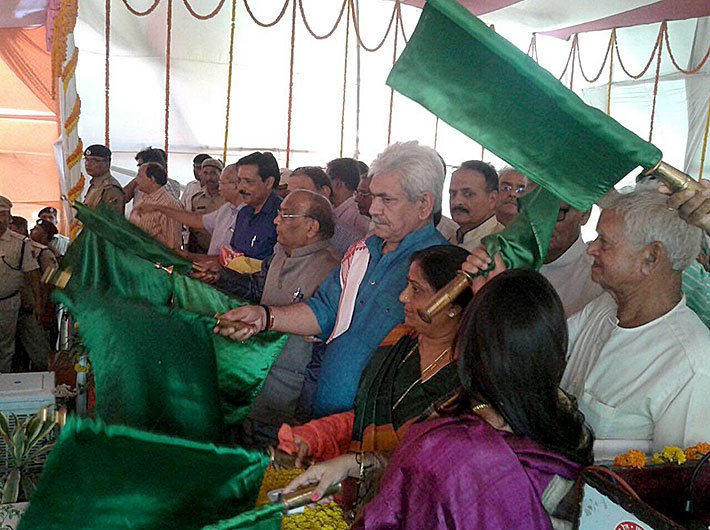Trains have started running over two new bridges in Bihar, drastically reducing travel time between important districts and towns
Leelawati still gets teary-eyed each time she recalls the tragic death of her husband. He passed away four years ago when the river Ganga swept him away in its strong current. A resident of Begusarai town, Leelawati’s husband had to go to the other side of the river, in Munger, to collect some important records of an ancestral land. He had two options: either travel 170 km for nearly six hours or cross the mighty river and save time. He chose the latter and paid the price with his life. Had there been a bridge over the river, he would have been alive today. Better late than never; there is one today.
On April 11, a train chugged off from Bihar’s Begusarai railway station towards Munger on a newly constructed road-rail bridge over the Ganga. This is expected to make things much easier for residents of adjoining areas including Khagaria and Jamalpur as well, with a significant reduction in travel time.
Begusarai and Munger are located on the opposite sides of the Ganga. Earlier, it used to take five to six hours to travel between the two towns, as one had to take a longer route covering 170 km. Similar was the case between Khagaria and Munger (also on the opposite sides of the Ganga), being a minimum six-hour journey and a distance of nearly 140 km.
But the situation is different today. Begusarai to Munger now just takes 60-70 minutes while Khagaria to Munger is 30-40 minutes’ journey.
“Better connectivity brings better progress and I am sure people will benefit from this,” Manoj Sinha, minister of state for railways who flagged off the first train on this bridge, told Governance Now.
The connectivity improved in February, when another rail-road bridge – Digha-Sonepur, connecting Digha Ghat in Patna and Pahleja Ghat in Sonepur – welcomed a regularly scheduled passenger train. This bridge, connecting the north and south of Bihar, is to be named after freedom fighter and social reformer Jayaprakash Narayan while the one connecting Begusarai and Munger will be named after Bihar’s first chief minister Sri Krishna Sinha.
It is not that there were no rail-road bridges in the state before. Three bridges – Mahatma Gandhi Setu, Vikramshila Setu and Rajendra bridge – stand on the entire 460 km length of the Ganga that passes through Bihar. But all are congested due to the large volume of traffic. Also, Rajendra bridge is being renovated, further slowing down the vehicle movement.
“Apart from the two mega bridges at Digha and Munger that have been completed at a cost of rs 5,700 crore, a parallel bridge along the Rajendra bridge will be constructed in a span of three years,” Sinha added.
The central government, in 2002, had approved the rail-road bridge at Munger at a cost of Rs 921 crore which was revised in 2012-13 to Rs 2,361 crore. This estimate was further revised in 2015 to Rs 2,774 crore with the railway’s share being Rs 1,247 crore. The construction of a road deck on the bridge over the Ganga, of 3.692 km length, has also been completed by the railways. The road is to be constructed by the state government for which land acquisition is underway.
Khagaria MLA Poonam Yadav says, “Due to congestion on roads, people used to prefer boats and steamers to reach their destination in the shortest possible time, but it used to be quite tedious.” Rohit Yadav is one such villager of Khagaria district who used to travel to Munger every day by boat and steamer. He says that life has now become trouble-free and will improve further when the rail-road bridge becomes fully functional.
People here are happy also for one more reason. Begusarai, Khagaria, Lakhisarai and Sheikhpura districts had been carved out of Munger a couple of decades ago. All original papers regarding registration of land, before the formation of Begusarai and Khagaria in 1972, are still with the original district Munger. “Since Munger is now a commissionerate, we are dependent on it. Earlier it used to take five to six hours to meet the commissioner or a deputy inspector general of police, but now it has become so easy to reach there – in just an hour from Begusarai and in half an hour from Khagaria,” says Saurav Kumar Singh who runs a printing press business in Begusarai.
This initiative is also expected to benefit business, tourism and culture. In Munger, there is a historically significant fort of Nawab of Bengal Mir Qasim. A yoga centre of world repute is also located there and is visited by thousands of people every year. “People can now get down from the Rajdhani Express in Barauni (Begusarai) junction and reach Munger in an hour. This will bring huge change in terms of business, especially in the hospitality sector, as the affluent class may stay in big hotels of Begusarai, situated on the main route of Delhi-Guwahati, and visit Munger thereafter,” says Rajkumar Singh, a young entrepreneur who runs a hotel and other businesses in Begusarai and adjoining areas.
It will also come as a boon for millions of pilgrims visiting Deoghar, home to the Baba Baidyanath temple – one of the 12 jyotirlingas. “Earlier, we had to cross the jam-packed Rajendra bridge. Now reaching Munger in an hour is like a miracle as it has brought Deoghar so close to us,” says Surinder Kumar Singh, a pilgrim who visits the temple every year.
“The bridge at Munger, the Digha bridge and another, under-construction, parallel to Rajendra Bridge, will make Bihar prosperous as people will be able to go to any part of the state without any hassle,” says former agriculture minister Ram Jeevan Singh.
Another project completed across the Ganga connects Digha in Patna to Sonepur on the other side of the Ganga. The total length of the bridge including the approach road is 28.353 km. The length of the bridge is 4.556 km and it connects Patliputra on the southern bank with Pahleza station in Sonepur on the northern bank. The bridge has 36 spans of 123 metres each and two shore spans of 64 metres at the either ends, with total length of 4,566 metres.
The construction of the road deck on the Ganga bridge has also been completed by the railways. Road approaches are to be constructed by the state government for which contracts have been awarded to Bihar State Development Corporation and Bihar Rajya Pul Nirman Nigam for south road approach works and north road approach works respectively.
The project was sanctioned initially as a rail bridge in 2001. In 2006, the rail-cum-road was approved. This new rail-cum-road has started easing the load on the Mahatma Gandhi road bridge which is in bad shape due to heavy congestion. It connects north and south Bihar. National Highway 19 on the north end and National Highway 98 on the south end get connected to the road link of the bridge. The estimated cost was revised in 2012 to Rs 2,921 crore with the railways share being Rs 1,681 crore and the road share being Rs 1,240 crore.
“This has made life easier for commuters to travel from Patna to Muzaffarpur via train as ealier there was only one circuitous route through Rajendrapul at Mokama,” said Lalan Paswan who used to get stuck in traffic congestion often at Mahatma Gandhi Setu road bridge. n
pankaj@governancenow.com
(The article appears in May 1-15,2016 edition of Governance Now)

